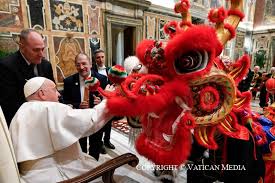 In response to my earlier post on Redeeming the Lion Dance for the Glory of God, I was asked about my view on a video which shows the Chinese Dragon Dance being performed in the Apostolic Palace and the Pope dotting the eye of the dragon. Re: link given in the comment section.
In response to my earlier post on Redeeming the Lion Dance for the Glory of God, I was asked about my view on a video which shows the Chinese Dragon Dance being performed in the Apostolic Palace and the Pope dotting the eye of the dragon. Re: link given in the comment section.
My understanding of the dragon dance in Chinese culture:
The dragon in Chinese culture is not inherently evil. It is actually a wise & benevolent creature. No surprise, many Chinese parents plan to have a (male) child in the year of the dragon. I asked many Chinese scholars whether the Chinese dragon exists & I get a blank look in their eyes. Their answer – the dragon is just a symbol, although to me religious symbols have spiritual consequences. Finally, the dragon was also used to symbolize the Emperor in ancient China. In the light of the positive perception of the dragon in Chinese culture, it is questionable whether the Chinese dragon should be associated with the evil dragon in the Book of Revelation and in Western culture. The application of the same English word to these two creatures is a historical accident or coincidence in literary translation.
However, with all due respect, I have problems with the Pope & the Catholic Church blessing the dragon dance as it is.
As in the lion dance, there are many superstitions surrounding the dragon in Chinese culture which are incompatible with Christian faith – e.g. the dragon dance is performed to bring good luck and drive off evil. It is concerning when one sees the Pope being involved in the “doting of the eye of the dragon” ceremony. The ceremony is supposed to give a soul or life force to awaken the dragon so that it then performs to bring prosperity & protection. It may be just a symbolic act in the minds of the advisers to the Pope, but in the eyes of many traditional Chinese, it is more than symbolic, it is a ceremony which spiritual consequences. Hence, while many of my Chinese Christians friends are proud of their cultural heritage, but they are unable to accept the “doting of the eye of the dragon” ceremony.
Social scientists & some Catholics theologians may rationalize these superstitions of Chinese culture with sophisticated jargon. But for some of us who have lived in the dark spiritual side of Chinese culture (despite the lofty values of Chinese culture), it is not simply an academic issue. There are deceptive and powerful spirits which exploit these superstitions & symbols to hold captive their believers in bondage of fear.
Speaking from personal experience, one of my uncles was a coffin maker. Another uncle was a Taoist monk who presided over Chinese funerals. Hey, my house was surrounded by a mortuary, a funeral parlor & a Chinese cemetery. I was familiar with frightening stories of certain incidents in the night. When we became Christians, we experienced deliverance from fear & bondage from these superstitions & deceptive spirits. What a joyful liberation from fear it was when we realized that the Holy Spirit who is in us is greater than he who is in the world (I John 4:4)! How can we ever return to these dark domains?
Related Posts
Redeeming the Lion Dance for the Glory of God?
Should the Church Adopt the Chinese Ritual of Ancestor Worship/Veneration?
Link to the video on the Pope dotting the eye of the dragon – https://www.tiktok.com/@doodskywalker/video/7335770297422892293
Video in Youtube – https://www.youtube.com/watch?v=PWg4bl95TFI
Through the hands of the Pope , it doesn’t matter what creature it is or believed to be , the dotting of the eyes ( what the Chinese say 開光)is to open the eyes so that they can see the True Light and brings no evil. Go share PEACE and FRATERNITY among human race .
Hi Fong Yong,
Great to hear from you. It has been a long long time since our Form 6 days. Good to know we are fellow brethren in Christ.
Thanks for sharing what explanation the advisors to the Pope may have in mind when they included the ceremony of the Pope doting of the eye of the dragon.
Just to note that there are two parts of the communication processes: 1) “encoding” – the sender encodes his thoughts and sends his message. 2) “decoding” – the recipient or audience decodes or interpret the message for themselves.
Oftentimes, the encoded message is easily distorted by the medium (evolving semantics or how meaning of words and action change over time, ambiguity of symbolic actions, just simply human misunderstandings etc). This is especially true in cross-cultural engagement and dialogue where long standing understanding of traditions is actually more determinative than the new interpretations offered. Hence, the message received is oftentimes not the same as the message received.
It is good to be mindful and to ensure that the message sent (what the advisors of the Pope have in mind) is the same as the message received (the audience – both Christians and the traditional non-believing Chinese).
Blessings and peace of Christ be with you.